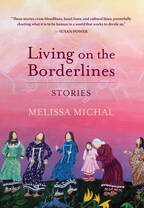Photo by Melissa Michal. Image with calm, gently rolling water shining from the sun not seen. Grassy dune hills surround a pathway to the beach.
Living on the Borderlines

The collection introduces contemporary Haudenosaunee characters who grow up in the city and are affected by intergenerational trauma. Its sixteen stories examine relationships informed or split wide open by the trauma, as well as the ways this community breaks destructive stereotypical and racist representations of American Indians from popular culture. Released from the Feminist Press February 12 2019. You can purchase copies here: www.feministpress.org/books-a-m/living-on-the-borderlines-stories
Along the Hills
Novel which weaves past, present, and future sections like our basket weaving with characters which are impacted by boarding schools, but whom also fight to reclaim Haudenosaunee land. The novel uses a lyric style and Indigenous Futurism elements to question contemporary governmental definitions of sovereignty, replacing this with a Haudenosaunee sovereignty. Some characters from Living Along the Borderlines reappear throughout.
The past section takes place in the late 1800s and follows a mother’s journey from the Midwest to upstate New York to find her daughter who has been missing for years. She was taken to a boarding school and she never returned. The present sections, set in Rochester, NY, incorporates many characters conflicted by the aftermath of boarding schools—each character’s journey unique to them. The future sections follow seven characters living on the Cattaraugus rez 50-60 years in the future, having all recently graduated from high school. The novel follows many protagonists, but focuses on contemporary Michah trying to find her identity, a past boarding school mother following her daughter’s pathway, and future Carrie, Jayden, and Lena rising up to get land back and to reclaim community history. There are buried bodies, stolen cars, Haudenosaunee love, and weapons pointed at our communities as well as Indigenous resilience and joy.
The first in a series, this novel will continue in two more novels set 50 years and 125 years into the future.
The past section takes place in the late 1800s and follows a mother’s journey from the Midwest to upstate New York to find her daughter who has been missing for years. She was taken to a boarding school and she never returned. The present sections, set in Rochester, NY, incorporates many characters conflicted by the aftermath of boarding schools—each character’s journey unique to them. The future sections follow seven characters living on the Cattaraugus rez 50-60 years in the future, having all recently graduated from high school. The novel follows many protagonists, but focuses on contemporary Michah trying to find her identity, a past boarding school mother following her daughter’s pathway, and future Carrie, Jayden, and Lena rising up to get land back and to reclaim community history. There are buried bodies, stolen cars, Haudenosaunee love, and weapons pointed at our communities as well as Indigenous resilience and joy.
The first in a series, this novel will continue in two more novels set 50 years and 125 years into the future.
Broken Blood
This lyric non-fiction essay collection blends historic and emotional pain with the strength of community and love and examining daily experiences with racism for American Indians. This collection will be an interactive Ebook which includes audio recordings of me performing certain lines and sections, videos and audio of community members and students, and a design which considers how oral elements can be represented within text.
Haudenosaunee Good Mind: Balance and Restoration in Literature Classrooms and Literary Criticism
This critical monograph argues for how to better incorporate American Indian issues into the classroom to combat literary erasure and genocide of the mind—concepts and theories I have developed. I use a narrative critical lens throughout this project which weaves together literary criticism, rhetoric, non-fiction, and interviews with students and teachers using story structures and elements as a type of witnessing. The tone and voice of this monograph include dialogues which can reach many readers and which follow the theory of LeAnne Howe’s tribalography where stories act as the theories for Indigenous communities.
Proudly powered by Weebly